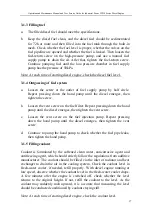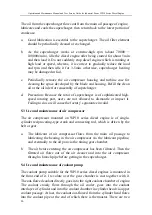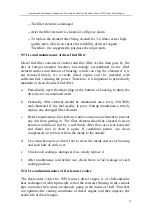
Operation and Maintenance Manual and User Service Guide for Industrial Power WP10 Series Diesel Engine
26
The oil from the supercharger flows out from the main oil passage of engine,
lubricates and cools the supercharger, then return back to the lower portion of
crankcase.
a.
Good lubrication is essential to the supercharger. The oil filter element
should be periodically cleaned or exchanged.
b.
As the supercharger works at extreme-high rpm (about 70000
~
100000r/min), idle the diesel engine after being started for about 5min
and then load it. Do not suddenly stop diesel engine which is running at
high load or speed, whereas, it is correct to gradually reduce the load
and rpm and then idle it for 3-5min. otherwise, supercharger bearing
may be damaged or fail.
c.
Periodically remove the air compressor housing and turbine case for
cleaning the space developed by the blade and housing. Refill the clean
oil at the oil inlet for reassembly of supercharger.
d.
Precaution: Because the rotor of supercharger is of sophisticated high-
speed rotating part, users are not allowed to dismantle or impact it.
Failing to do so will cause the factory’s guarantee invalid.
5.3 Use and maintenance of air compressor
The air compressor mounted on WP10 series diesel engine is of single-
cylinder reciprocating-type crank and connecting rod, which is driven by the
belt or gear.
a.
The lubricant of air compressor flows from the main oil passage to
lubricating the bearing in the air compressor via the lubricant pipeline,
and eventually to the oil pan via the timing gear chamber.
b.
The air before entering the air compressor has been filtrated. Then the
filtrated air flows out of the air cleaner and into the air compressor
through a branch pipe before getting in the supercharger.
5.4 Use and maintenance of coolant pump
The coolant pump suitable for the WP10 series diesel engines is mounted in
the front end of it. Its volute over the gear chamber is cast together with it.
The out-flowed coolant directly goes into the right coolant chamber of engine.
The coolant crossly flows through the oil cooler, goes into the coolant
interlayer of cylinder and into the coolant chamber in cylinder head via upper
coolant passage. At last, the coolant out-flowed from the cylinder head flows
into the coolant pipe at the end of which there is thermostat. There are two
















































